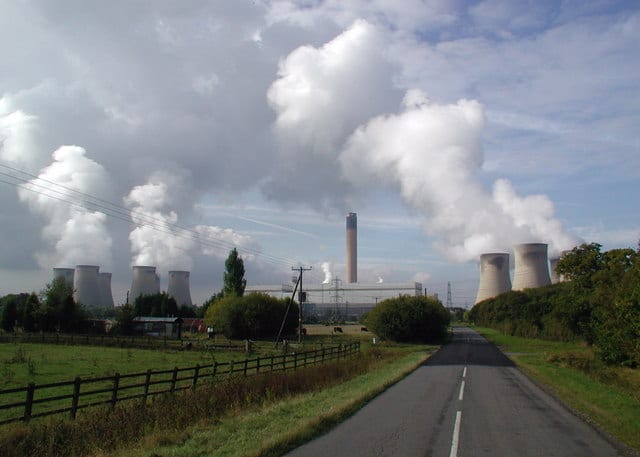A bioenergy declaration signed by Drax during COP26 is further proof of the company’s “greenwashing”, campaigners have claimed.
The Yorkshire-based biomass giant is among over a dozen signatories to an industry-backed document that claims bioenergy could increase its output to nearly threefold, and reduce net global emissions by over one billion tonnes of carbon dioxide by 2050.
However, campaigners and experts say the document, which cites the International Energy Agency’s (IEA) Net Zero Emissions scenario, is fundamentally misleading.
“This so-called ‘Glasgow declaration on sustainable bioenergy’ is not an official COP document,” Sally Clark, from biomass campaign group Biofuelwatch, told DeSmog.
“It is simply another attempt by Drax and other companies in the wood pellet and biomass industries to greenwash dangerous false solutions. Our forests and climate are under threat like never before and polluters like Drax should have no place at climate talks.”
‘A Vision’
Drax, which last year received over £800 million in UK government subsidies to burn wood pellets for energy, previously operated one of Europe’s largest coal-fired power stations.
The company has now converted four of its six plants to biomass, which is categorised as a renewable energy under UK law.
“Converting Drax power station to use sustainable biomass instead of coal transformed the business into Europe’s biggest decarbonisation project and has helped Britain decarbonise its electricity system at a faster rate than any other major economy,” said a Drax spokesperson.
Recent research has found that Drax is the single biggest emitter of carbon dioxide in the UK. The Yorkshire power station, which sources wood pellets from the southeastern United States and from Canada, has piloted the BECCS (bioenergy with carbon capture storage) technology since 2018, and aims to deliver its first fully operational plant by 2027 as part of plans to become a “carbon negative company” by 2030.
“We have reduced our emissions by more than 90 percent in the last decade,” the Drax spokesperson added. “Drax is now one of Europe’s lowest carbon energy generators – and we plan to go further with BECCS, permanently removing millions of tonnes of CO2 from the atmosphere by 2030.”
Studies have raised major concerns over the sustainability of the wood Drax uses to make pellets, the carbon footprint of transporting wood pellets thousands of miles from Louisiana in the U.S. to Yorkshire, in the UK, and the emissions impact of burning wood for power.
Despite this, the document offers an optimistic take on bioenergy. The energy source is “crucial to achieving net zero emissions globally,” it claims. The document “represents a vision for the growth of the wood-based sustainable bioenergy sector over the next 10 to 30 years”.
The document, whose signatories include pellet producer Enviva and the Association of Renewable Energy and Technology (REA), refers to the IEA scenario to support its claims around sustainability, a crucial source of contention around bioenergy.
Duncan Brack, policy analyst and adviser at think tank Chatham House, however, said the report contains a number of miscalculations, including on how it defines “sustainable wood-based bioenergy’.
According to Brack, this is not limited to residues. These include the remnants of field agricultural crops, such as stalks, leaves, straw, and waste from pruning, and also includes low-grade roundwood — a bi-product of harvesting for saw-timber production, and thinnings. The latter two, however, are both from whole trees, Brack said, and have a greater climate impact than using genuine residues.
The declaration also lacked any discussion on whether supply chain controls are adequate to allow for sustainably managed forests, Brack said.
“It is welcome that the biomass industry is paying more attention to the impact of their activities on forest carbon stocks,” he noted. “But by failing to distinguish between biomass feedstocks on the basis of their impact on the climate, their so-called ‘sustainability principles’ will continue to result in increased carbon emissions to the atmosphere.
“This is incompatible with the commitment in the Paris Agreement to see emissions peak ‘as soon as possible’ and is a very poor use of electricity bill-payers’ money.”
Drax Presence at COP26
Drax chief executive Will Gardiner and Clare Harbord, group director of corporate affairs, both spoke at COP26 side events on the benefits of sustainable biomass and bioenergy with carbon capture and storage (BECCS).
Gardiner, who came to the climate conference as part of the World Bioenergy Association (WBA) delegation, addressed a panel at the Sustainable Innovation Forum 2021, where he discussed the ‘Green Industrial Revolution’ and the role of carbon capture in “decarbonising industrial clusters”.
He also spoke at a WBA event on “Unlocking Net Zero through investment in sustainable bioenergy and BECCs”, alongside U.S. wood pellet manufacturer Enviva and former UK Energy Secretary Amber Rudd, who has joined Norwegian oil company Equinor as chair of its international advisory group.
DeSmog last week reported how Gardiner also took part in a panel on transitioning away from coal-fired power as part of the summit’s themed “energy day”.
Harbord, who was previously director of corporate affairs at Heathrow Airport, also spoke about carbon capture at an event sponsored by Mitsubishi Heavy Industries, a Japanese multinational engineering company which produces commercial aircraft and aero engines.
A Drax spokesperson said: “The climate crisis is the biggest challenge the world faces, and we make no apology for attending the climate conference in Glasgow. The aim of COP26 was to bring businesses, governments, NGOs, and other organisations together to share ideas, and create momentum and action in delivering the solutions the world desperately needs to address the climate emergency.”
Ajay Gambhir, senior research fellow at the Imperial College London Grantham Institute for climate change and the environment, said it was well-recognised that biomass would occupy a role in net-zero pathways.
“It’s not surprising to see the bioenergy industries and organisations pushing this potential solution at this vital moment,” he said, “but time will tell whether we can achieve this with multiple other pressures on land use over the coming decades”.
Subscribe to our newsletter
Stay up to date with DeSmog news and alerts







